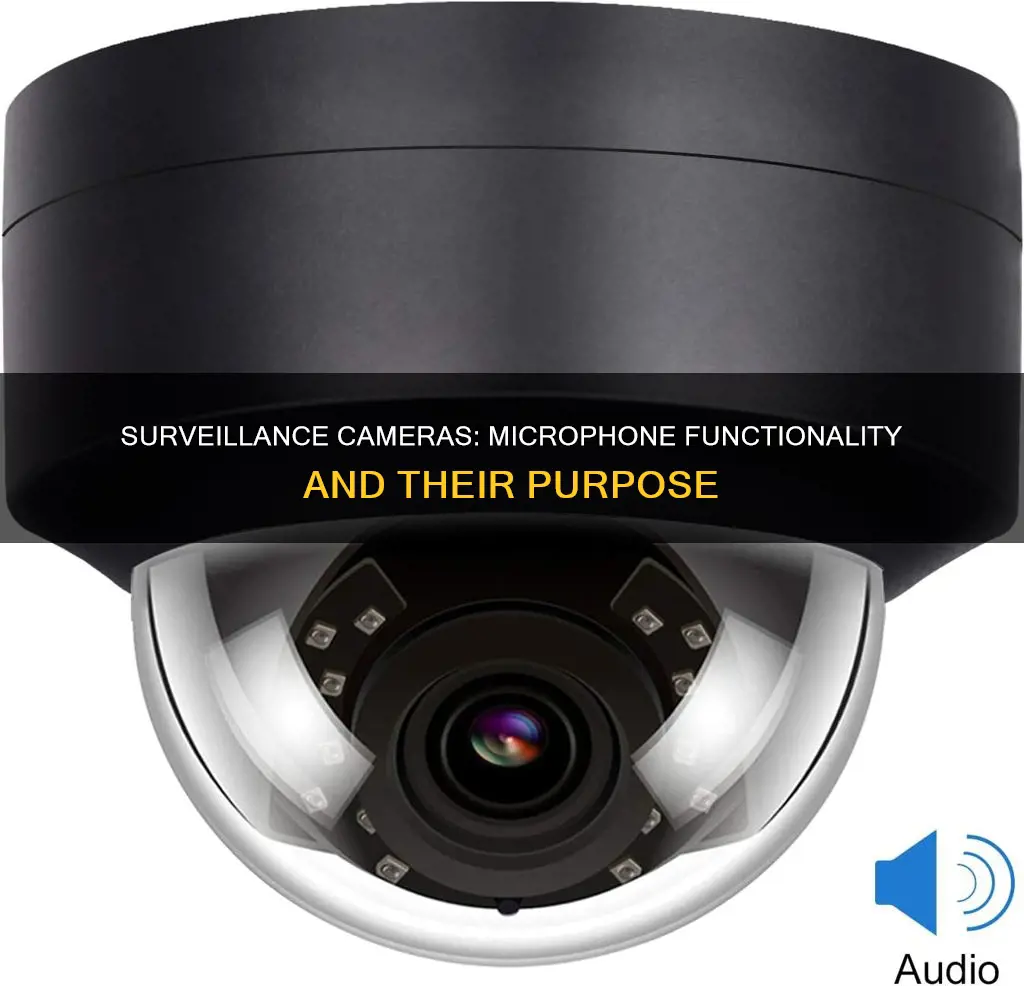
Surveillance cameras with built-in microphones are becoming increasingly popular among homeowners and businesses looking to enhance their security systems. These microphones are used to record audio in addition to video footage, providing crucial extra documentation and context beyond just visuals. They can be used to detect noises and listen in on conversations within a radius of up to 40 feet, depending on the ambient noise. This makes it easier to identify incidents and suspicious behaviour. Built-in microphones also enable two-way intercom functionality, allowing users to communicate through the camera using a smartphone app or desktop client.
What You'll Learn

Built-in microphones vs. external microphones
Surveillance cameras with built-in microphones are becoming increasingly popular among homeowners and businesses looking to enhance their security systems. These devices combine high-definition video with clear audio recording, providing next-level monitoring and evidence-gathering capabilities. However, you may also choose to use an external microphone with your surveillance camera, which can offer improved audio quality.
Built-in Microphones
Built-in microphones are easy to use and can be connected directly to a compatible security camera recorder. They combine two key surveillance components, video and audio, into a single solution for fuller coverage and evidence documentation. Many built-in microphones also offer two-way intercom functionality, allowing users to listen in and speak through the camera using a smartphone app or desktop client. Built-in microphones are typically designed for indoor use and may not be as weather-resistant as external microphones.
External Microphones
External microphones can provide higher-quality audio recording than built-in microphones. They are ideal if you plan to record sound for purposes beyond a simple video call, such as starting a podcast or recording music. External microphones offer more flexibility in terms of positioning and can be directed towards the desired audio source. They also have more advanced mechanics, allowing for higher-quality audio capture. However, they may require additional cables or power sources, adding complexity and cost to your setup.
Factors to Consider
When choosing between a built-in and external microphone, consider your specific needs and constraints. If you require high-quality audio, an external microphone is likely the better option. If ease of use and convenience are more important, a built-in microphone may be sufficient. Additionally, consider the environment in which the camera will be used. Built-in microphones are better suited for indoor use, while external microphones can be more durable and weather-resistant for outdoor use.
Lithium Batteries: Kodak EasyShare Camera Power Source
You may want to see also

Surveillance cameras with two-way audio
Benefits of Two-Way Audio
Two-way audio cameras have a wide range of benefits, including:
- Evidence gathering: Audio recordings can provide crucial extra context and documentation to video footage, making it easier to discern incidents and suspicious behaviours.
- Real-time communication: Users can communicate with family members, delivery people, and pets remotely. This can be particularly useful for checking in on children or elderly parents.
- Noise detection: Cameras can be set up to detect loud noises and send real-time notifications when certain sound thresholds are exceeded, acting as an audio detector.
- Smart home integration: Some cameras can integrate with smart speakers like Amazon Alexa or Google Home, allowing for voice-enabled features and remote control.
- Motion detection: Cameras with two-way audio often have motion detection capabilities, sending alerts and recording footage when movement is detected.
Types of Two-Way Audio Cameras
There are several types of two-way audio cameras available, including:
- Outdoor cameras: These cameras are designed to withstand various weather conditions and are typically placed in areas such as the front door, porch, or garage.
- Indoor cameras: Indoor cameras are designed for use inside homes and can be used as nanny cams, baby monitors, or pet cameras.
- Wireless cameras: Wireless cameras are easy to install and are often battery-powered, connecting to a WiFi or cellular network.
- Wired cameras: Wired cameras use physical cable connections for power and data transmission, typically relying on Ethernet cables or DC power cables.
Considerations When Buying a Two-Way Audio Camera
When purchasing a two-way audio camera, it is important to consider the sound quality, including the volume, clarity, and any delays in the two-way communication. It is also crucial to ensure the camera is waterproof and has night vision capabilities for outdoor use. Additionally, checking customer reviews and professional editor reviews can help assess the overall performance of the camera.
Understanding Camera Raw Histogram: A Beginner's Guide
You may want to see also

Surveillance microphones for indoor vs. outdoor use
Surveillance cameras with built-in microphones are becoming more popular for homeowners and businesses alike, as they provide next-level monitoring and evidence gathering. They are also useful for detecting loud noises and triggering real-time alerts.
When choosing a surveillance microphone, it is important to consider the intended use and environment. For example, indoor and outdoor microphones have different specifications.
Indoor Surveillance Microphones
Indoor surveillance microphones are typically used in settings such as grocery stores, banks, police interrogation rooms, or anywhere where a verbal exchange between individuals may need to be reviewed. They can be in-line microphones that share a power source with the camera, or standalone microphones with their own power source. In-line microphones need to be located close to the camera, while standalone microphones can be placed anywhere.
Outdoor Surveillance Microphones
Outdoor surveillance microphones are designed to withstand the elements and are usually weather-resistant or weatherproof. They are suitable for use in outdoor areas such as scrap yards or anywhere that requires audio recording. For optimal performance, it is important to follow the design specifications to protect the microphone from moisture damage and interference.
When selecting a surveillance microphone, factors such as sensitivity range, noise reduction performance, durability, and mobile app connectivity should be considered. Additionally, it is important to be aware of and comply with any federal, state, and local laws regarding audio surveillance.
Unlocking Camera Raw: Unfiltered Power for Your Photos
You may want to see also

Surveillance microphones for different spaces
Surveillance cameras with built-in microphones are becoming increasingly popular among homeowners and businesses looking to enhance their security systems. These devices combine high-definition video with clear audio recording, providing next-level monitoring and evidence gathering.
When it comes to choosing the right surveillance microphone, there are several options available, each with its own advantages and ideal use cases. Here are some considerations for different spaces:
- Indoor vs. Outdoor Spaces: Indoor microphones are typically more sensitive and may not be as weather-resistant as outdoor microphones. Outdoor microphones, on the other hand, are designed to withstand the elements and often feature weatherproof enclosures to protect them from moisture and interference.
- Noise Levels: In locations with high levels of background noise, such as industrial settings with machinery, consider using microphones with built-in equalizers to filter out the noise and focus on capturing conversations.
- Directionality: Omni-directional microphones pick up sound from all directions, making them ideal for indoor spaces where you want to capture conversations in a room. On the other hand, directional microphones, like shotgun microphones, are more suitable for outdoor use or large, open spaces as they focus on capturing sound from a specific direction.
- Mounting Options: Depending on the space, consider the mounting options available for the microphone. Some microphones are designed for flush mounting, while others are surface-mounted or attached to a camera.
- Two-Way Communication: Many surveillance cameras with microphones also feature built-in speakers, enabling two-way intercom functionality. This allows users to listen and speak through the camera, making it useful for front porches, offices, or customer service interactions.
- Sensitivity and Range: The sensitivity and range of the microphone are crucial factors. Look for microphones with a sensitivity range of -12dB or lower, which can pick up faint noises. Additionally, consider the distance the microphone needs to cover; some microphones are designed for short-range, while others can capture sound from longer distances.
- Integration with Other Devices: Some advanced security cameras integrate with smart speakers like Amazon Alexa or Google Home, allowing for voice-enabled features and remote control of the camera's audio and video functions.
- Legal Considerations: It is important to consult local laws and regulations regarding audio surveillance. Some states or countries may have strict "two-party consent" laws, requiring both parties to be aware of and consent to audio recording.
By considering these factors, you can choose the most suitable surveillance microphone for your specific space and needs, ensuring effective monitoring and evidence gathering while also complying with legal requirements.
Dodge Charger GT: Reverse Camera Availability
You may want to see also

Surveillance microphones and privacy laws
Surveillance cameras with built-in microphones are becoming increasingly popular among homeowners and businesses. These devices combine high-definition video with clear audio recording, providing next-level monitoring and evidence gathering. They can detect loud noises, listen in on conversations, and trigger real-time push notifications when set sound thresholds are exceeded.
However, the use of surveillance microphones raises serious privacy concerns. Audio surveillance can be significantly more intrusive than video surveillance, as it can capture private conversations. While video surveillance in public spaces is now commonplace, very few cameras include microphones due to strict privacy laws.
In the United States, the federal Wiretap Act prohibits anyone from secretly recording conversations that another person believes are private. However, the act does not apply if at least one person in the conversation consents to being recorded. Most states have specific regulations that govern the use of electronic recordings of conversations, with some requiring two-party consent for recording, while others only require one-party consent.
The placement of surveillance microphones in public places has been a subject of controversy. For example, the installation of live microphones in public hallways as part of the security system in Green Bay City Hall was met with objections from politicians and members of the Wisconsin State Senate, who subsequently filed a lawsuit. Similar deployments have been uncovered in the district attorney's office in Nashville and the city clerk's office in East Providence, Rhode Island.
The use of surveillance microphones in public spaces is legally problematic and susceptible to abuse. While defenders of these practices argue that individuals have no reasonable expectation of privacy in public places, the context is crucial. Blanket audio surveillance in areas where private conversations may occur, such as city halls or district attorney's offices, is a significant invasion of privacy.
To address these concerns, it is recommended that individuals research their local, county, state, and federal surveillance laws before installing security cameras in their homes or businesses. Additionally, companies should ensure that their customers have a clear understanding of what data is being collected and how long it is retained.
Live Focus Camera: Capturing Photos with Artistic Bokeh Effects
You may want to see also
Frequently asked questions
A built-in microphone on a surveillance camera allows for the recording of audio in addition to video footage, providing fuller coverage and evidence documentation.
Recording audio allows the camera to detect noises and listen in on conversations within range, providing crucial extra documentation and context beyond just visuals.
Most IP security cameras with audio input capabilities have an RCA audio connector on their pigtail for connecting a microphone. Alternatively, some dome IP cameras have a connection block inside the dome.
Security camera microphones are sensitive enough to pick up sounds from a 40ft radius in a quiet room, although results may vary depending on ambient noise levels.
Yes, laws regarding audio recording vary depending on your location. It's important to check with local law enforcement or town clerks before enabling any type of audio recording to ensure compliance with privacy regulations.







